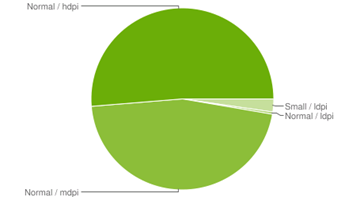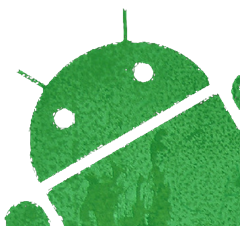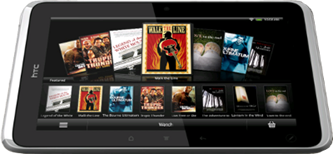HTC = Heady Tablet Computing!
I used to have an HTC Mogul phone. It was windows based and I loved the attention to detail HTC made when it came to UI design. Things like a windshield wiper when weather said it was raining, or lazy clouds drifting in front of the sun or moon. One thing that drove me nuts was the clock, though; how it would slowly flip the hour and minutes before showing the correct time. Too many times, I would power it up and glance at the time twice before realizing what was going on. HTC isn’t perfect, but they have always impressed me with their user experience.
Well, HTC’s Flyer tablet is coming, and it looks like its going to be a seriously cool device.
This tablet looks seriously fun, seriously innovative, and seriously worthy of some its pre-release hype. Numerous sites are reporting there are already over 1M Flyers ordered. It has features that would have been welcome on the iPad2. Maybe the Apple will leapfrog everyone else with the iPad3.
However, this is the HTC Flyer and it looks like so much fun.
It weighs in @ 420 Grams (14.82 ounces) with battery. It sports a 7” screen (1024×600) resolution.
It’s Android based with HTC Sense on top of it. This means if you like Sense, you might have to wait for Android updates lest they break your UI. HTC is good about updates, though.
It sports a 5 megapixel rear camera and 1.3 megapixel front camera as well as a compass, G-Sensor, Wifi, Bluetooth 3.0 w/ A2DP, and GPS.
It comes with 32GB of internal storage and a GB of RAM, and it has a microSD expansion slot (SD 2.0 compatible). That means up to 32GB of swappable SD storage.
 The HTC Flyer also has a standard micro-USB port, but I’ve not found anything about any limitations of usage. I hope we can attach a keyboard and mouse!
The HTC Flyer also has a standard micro-USB port, but I’ve not found anything about any limitations of usage. I hope we can attach a keyboard and mouse!
It’s about a half an inch (.52” to be specific) thick, meaning its around 5mm thicker than the iPad 2. The iPad 2 is very slim, perhaps the biggest feature it sports.
With the 7 inch screen, it enters the ring 4.8” wide and 7.7” tall.
The CPU is reported to be based on a Qualcomm Snapdragon processor. The MSM8255 is a single core CPU, which is disappointing, but hopefully with the the built in Adreno GPU the lack of a 2nd core won’t be quite so obvious. I wish it had a dual core CPU, but it is coming with Android 2.3 (not 3.0). We’ll have to wait and see. The Adreno has a reputation for eye-popping 3D graphics, so there is some pedigree here.
Early specs speak to HDMI out as well and DLNA.
Combine those with the Flyer’s OnLive support and gaming tablet niche is about to get pwned. This tablet may have the PSP squarely in its sites, as well as some rarely used consoles collecting dust in living rooms everywhere.
Then there’s the HTC Magic Pen.
Is this old school or something new? It’s a pen (aka stylus) that you use to draw, paint, and write with on the tablet. It can also work as a highlighter. Basically, if it’s on the screen, the HTC Scribe app + Magic Pen means you can notate, collate, and otherwise pretty much draw on with the data as you see fit.
It is being said the stylus will enhance the use of the tablet by letting the user use tools like evernote and making notes in e-books. One thing is that it supposedly knows when your hand is on the screen when you’re drawing (See Video Below).
Pens and tablets aren’t anything new, but it seems like HTC may have come across an elegant way to re-introduce this technology. As someone who has been lingering on the graphics tablet isle because I would like the ability to freehand some graphics and UI elements, I’m extremely intrigued. Tablets are normally great for data consumption, not creation.
Here’s the pen in action:
Of course, it’s got 3G connectivity. WCDMA and HSPA and Quad-band GSM/GPRS/EDGE. That pretty much covers everything.
All I can say is I hope the Flyer is not too expensive. Early indicators are that that its going to be a pricy tablet.
I’d certainly take one!
Apparently, Android Fragmentation is a bunch of FUD.
I develop for both the Android the iPhone platforms in Java and Objective-C. When it comes to Android, I’ve always considered Android 1.6 (API level 4) a good development target because so many devices were released with that version and I was ensured my apps would work going forward. However, perhaps the inexpensive phones are helping the Android market maintain an equally aggressive refresh cycle.
As of today, inzi.com’s minimum Android target is 2.1.
Google has a webpage for developers so they can get visibility into the Android marketplace. If you create Android applications, and you want to focus on the platform, this site is an important quarterly consumable.
As you can see, a vast majority of all Android devices are now on Android 2.1 or higher. It’s a big majority, almost 90% (89.08%).
Lately, a lot of people have been calling the various versions of Android in the market fragmentation. Fragmentation in the mobile industry, it seems, is being or has been redefined.
If you think this is fragmentation, let me tell you about the old school mobile app market. J2ME fragmentation was horrible in the previous generation. During that time, J2ME fragmentation referred to incomplete and / or incompatible APIs. One app might work on one phone but not another. Sun didn’t require a minimum level of compatibility or API by the phone manufacturers. So they’d make their own APIs. It was a nightmare.
However, just because Android 1.6 exists in the wild, that doesn’t mean the android market is fragmented. Consider that iPhone developers focus on version 3.x and 4.x. Additionally, Android APIs are forward compatible, so is fragmentation real or FUD?
This interesting piece on computerworld.com ought to tell you everything you wanted to know. Spacetime Studios, maker of the popular Pocket Legends 3D MMO game for both iOS and Android, says Android usage is double that of iOS in practically every measure. Their CEO is quoted as saying “Android has become our primary interest.”
The current 90% 2.1 or better status is a big improvement over July 2010. At that time, just over 55% of devices were running Android 2.1. The shift to the current state may have been helped by a few factors such as the delay of Android 2.3 and the aggressive pricing on Android based phones.
 With all the brew-ha-ha about Android fragmentation being referenced as an absolute around the Internet, it seems the device info at Android.com tells a fairly different story.
With all the brew-ha-ha about Android fragmentation being referenced as an absolute around the Internet, it seems the device info at Android.com tells a fairly different story.
Granted, this information changes with the release of new devices like the Xoom and other tabs. However, right now, if you’re thinking of writing software for the Android, this information should tell you want you want to know.
This info tells us, as Android developers, what to target with our code for apps being released today:
A) Code to Android 2.1 minimum
and
B) Design your UI for mdpi and hdpi.
In doing so, we’ll cover a vast majority of modern Android devices. Additionally, the marketplace will hide our app from older phones ensuring no one installs it and experiences force closes.
These two pieces of information are critical to establishing a baseline from which to work. This affords us the opportunity to focus on use experience and Application features.
Considering that user interface design is one of the more challenging aspects of Android development, focusing only hdpi and mdpi will save us all a lot of headache. However, the smaller displays mustn’t be forgotten. There are still Android users out there.
Feel free to ask questions about this below if you’re considering moving into the Android space.
Top 5 reasons the #3 smartphone is the #1 target for app developers
I certainly don’t hide my preference for Android over iOS, but that certainly doesn’t mean I don’t like Apple products. I prefer an open platform, with all its risks and shortcomings, over the walled garden model. Despite the recent malware scare that’s making headlines, the Android platform has passed palm and is now the #1 smartphone in the U.S.
Some may argue that Android’s success is because the phones are cheaper, easier to get, or that they’re on more carriers. Regardless, the open platform’s proliferation is real; and the reasons for its successes are likely somewhere between the cheers of its supporters and the excuses of its detractors.
However, in the mobile space the Apple iPhone / iPad are still the #1 target for mobile developers. Here’s a list of of the top 5 reasons why I think this is so. How will manufacturers of Android devices and phones overcome these? Do they need to?
#5 App Store Superiority
 Right now, the Apple App Store is just better and more well executed, despite it’s shortcomings. Despite challenges with Apple’s inconsistent and esoteric approval processes, the apps that get approved are consistently quality and seamlessly blend with the user experience.
Right now, the Apple App Store is just better and more well executed, despite it’s shortcomings. Despite challenges with Apple’s inconsistent and esoteric approval processes, the apps that get approved are consistently quality and seamlessly blend with the user experience.
Additionally, there’s only one Apple App Store, while in the Android space we have more than the Marketplace, but we have various Manufacturer’s marketplaces (Archos, for example) with Amazon about to dilute the space even more. (note to self, maybe I should write a marketplace abstraction app where we could see apps in all marketplaces in one place!).
#4 Developer Support (aka The Feedback Loop)
The developers target the Apple platform because of it is the #1 app target and that’s where the money is to be made. The Apple platform is the #1 app target because of developer support. The industry makes tools to make creation of apps on the #1 platform easier. So now more developers target the Apple platform.
developers target the Apple platform.
I believe this cycle will eventually collapse. In fact, I think we’re already seeing the beginning of this process. Apple’s recently fee demands for subscription content have caused quite a bit of complaining. However, you may have noticed a new ‘book’ section in the Marketplace. How long before we see subscriptions?
Additionally, Apple won’t approve apps that are poorly written or for other reasons. It’s their garden, they decide what goes in. So, they act as sort of a quality control agent that doesn’t exist in the Android Marketplace (today). As an Android developer, I’d pay a submission fee to have my app QA’d and checked by Google in exchange for more marketplace visibility in a heartbeat.
Right now, though, the App app store has a higher percentage of quality apps.
#3 Cult of Mac (aka the coolness factor)
 Apple is one heck of a marketing company. Apple has successfully marketed their consumerism as counter culture and somehow outside the status quo; and it is. Apple’s walled garden market philosophy capitalized on what many people found lacking in the windows space (as well as in the formerly niche smartphone market). Apple’s tight reigns protect their great user experience. In the end, that’s Apple’s differentiator. Apple moved into the mobile space and did so in a big way; pushing the carriers aside as the ultimate authority on what goes on the device and bringing about a faux democratization of mobile development to the market. Handango is nothing like it used to be.
Apple is one heck of a marketing company. Apple has successfully marketed their consumerism as counter culture and somehow outside the status quo; and it is. Apple’s walled garden market philosophy capitalized on what many people found lacking in the windows space (as well as in the formerly niche smartphone market). Apple’s tight reigns protect their great user experience. In the end, that’s Apple’s differentiator. Apple moved into the mobile space and did so in a big way; pushing the carriers aside as the ultimate authority on what goes on the device and bringing about a faux democratization of mobile development to the market. Handango is nothing like it used to be.
Remember when the iPhone was considered an iPod with a phone built in? Either way, it was released and the silhouettes danced; and we gobbled it up!
Apple’s customers and fans religiously evangelize everyone else on behalf of this large corporate entity. To the point that even the pope weighs in. Seriously, check out that link to techcrunch. The “cult of mac” is nothing new, but I find it surprising how the cult of mac has never been more slickly marketed and subsequently adopted by counter culture proponents. It all seems counterintuitive to me, but perhaps that’s why I don’t get it. However, very few mac fanatics will admit or even acknowledge how some in their ranks can be unbearably snobbish. My Apple fanatic friends are going to give me grief on this on Facebook; hopefully they don’t go about unwittingly proving my point!
The end result is the popularity of the platform will receive the same benefits other platforms receive. See #4.
#2 Consumer confidence in apps worth sharing
Another example of slick marketing is the catch phrase “there’s an app for that”. IPhone users revel in the culture carefully crafted by Apple of app “one-upmanship”. Finding the latest app seems to have replaced being the first to see the latest blockbuster. It’s certainly less expensive! Download app, install, tweet, receive kudos from social circle, repeat.
 Discovering a cool app (free or paid) and sharing it with your friends is both enjoyable and satisfying at the same time (and profitable it seems). Perhaps it feeds some primal, lizard part of our brain. A hunter / gatherer type of thing?
Discovering a cool app (free or paid) and sharing it with your friends is both enjoyable and satisfying at the same time (and profitable it seems). Perhaps it feeds some primal, lizard part of our brain. A hunter / gatherer type of thing?
Socials apps benefit directly from such behavior. Building on #3, as the cult of mac spreads so does the popularity of apps targeting the platform. This is the secondary feedback loop.
I personally find discovery of cool Android apps a lot of fun, but it becomes harder every day with so much junk in the marketplace (See #5 and #4). Also, we’ll see how successful Apple is at keeping Android Malware stories in the news cycle.
Apple’s tight approval process means when a user downloads an app from the Apple app store, they can be confident that the app will be stable, relevant to its description, and consistent with the user experience. Granted, the apps may not have the opportunity to be as flexible as an Android app; but it’s all about the user experience.
Happy users = happy recommendations = happy purchases = happy developer’s pocketbook.
You don’t have to go to a seminar or read the latest entrepreneur’s power blog to grasp this.
#1 Consistency of platform
All of this is possible because of the walled garden Apple has created. There are only so many platforms of iPhone you have to code for.
In the Android world, we have a plethora of devices with different screen resolutions. Additionally, we’ve gone through a fairly accelerated release cycle. From 1.6 (which is the lowest platform I target) to 2.3 and soon Android 3.0. Thankfully, Google is keeping the API fairly consistent.
fairly accelerated release cycle. From 1.6 (which is the lowest platform I target) to 2.3 and soon Android 3.0. Thankfully, Google is keeping the API fairly consistent.
However, it’s just easier to target a large percentage of the smartphone market with limited platform fragmentation. In other words, its easier to write an app for the iPhone that will run on x percentage of the market than write for the Android platform and hope your UI renders properly. I’m not saying it’s better one way or the other; but it is easier.
If you’ve been in the mobile space for a while, you recognize that Apple capitalized on a market that was so fragmented that consistent delivery of working apps was very difficult. As long as Google avoids the same mistakes Sun made with J2ME, I believe the Android platform should eventually dominate this market; even from an application standpoint.
If anything, I believe the company with the most to lose in the long term is Microsoft.

